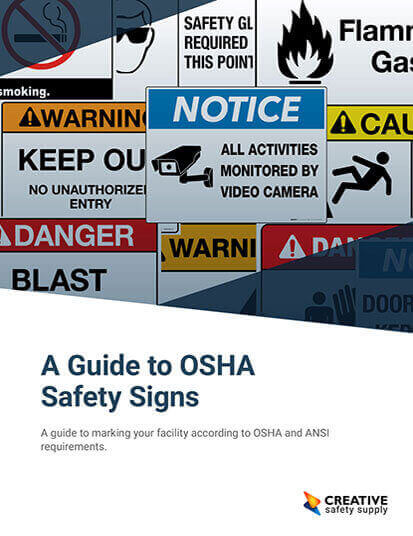
In any environment, safety is paramount, and the presence of clear and visible emergency exit signs is crucial for ensuring the well-being of occupants. But where exactly are these signs required, and why are they so significant? This comprehensive guide aims to shed light on OSHA and NFPA regulations and significance of emergency exit signs, exploring their historical background, core elements, and practical applications. By the end of this article, you will have a thorough understanding of the necessity and impact of properly placed emergency exit signs.
The Importance of Emergency Exit Signs
Emergency exit signs are not mere symbols; they are critical safety features that guide individuals to safety during crises. These signs provide clear, easily recognizable instructions, even in low-light or high-stress situations, ensuring swift and safe evacuation. In addition to all this, they are also required and regulated by organizations such as OSHA (Occupational Safety and Health Administration). The OSHA guidelines for "Exit Routes and Emergency Planning" fall under 29 CFR 1910.37 and provide comprehensive information on when and where exit signs should be placed. The NFPA (National Fire Protection Association) also has a code titled "Life Safety Code 101" that provides more context and information on the subject.
Historical Background: Evolution of Emergency Exit Sign Regulations
The concept of emergency exit signs has evolved over time, driven by a need to improve safety in public spaces. Early iterations were basic, often relying on simple directional arrows. However, as understanding of human behavior during emergencies grew, so did the sophistication and standardization of exit signage. Today, strict regulations govern the placement and characteristics of emergency exit signs to ensure uniformity and effectiveness.
Core Elements of Emergency Exit Sign Placement
1. High Visibility
Emergency exit signs must be easily visible under various lighting conditions, including low light or smoke-filled environments. This is achieved through the use of clear, legible text, and internationally recognized symbols.
2. Strategic Placement
Signs should be strategically positioned to provide clear guidance towards the nearest exit. This includes corridors, stairwells, and intersections within a building.
3. Illumination and Power Backup
Emergency exit signs are often required to be internally illuminated or externally lit by emergency lighting systems. Additionally, backup power sources, such as batteries or generators, ensure that signs remain lit during power outages.
4. Compliance with Regulations
Regulatory bodies, such as building codes and fire safety standards, set specific requirements for the placement and characteristics of emergency exit signs. Compliance with these regulations is crucial to ensure the safety of building occupants.
Significance Within Their Respective Domain
Commercial Buildings
In commercial buildings, emergency exit signs are a legal requirement to ensure the safety of employees, customers, and visitors. Proper placement and visibility of exit signs are critical for compliance with building codes and fire safety regulations.
Educational Institutions
Schools and universities are required to have clear and well-lit emergency exit signage to facilitate safe evacuations during drills or actual emergencies. These signs play a crucial role in protecting students, staff, and faculty.
Healthcare Facilities
Hospitals and healthcare facilities must adhere to strict regulations regarding emergency exit signage. Clear exit pathways are essential for the swift evacuation of patients, visitors, and healthcare professionals in the event of an emergency.
Residential Buildings
In multifamily residential buildings, emergency exit signs are important for the safety of residents. Properly placed signs help occupants navigate to safety during emergencies like fires or natural disasters.
Creating an Organized and Efficient Environment
Implementing proper emergency exit sign placement results in a more organized and efficient environment by:
- Reducing Panic and Confusion: Clear and visible exit signs minimize panic and confusion during emergencies, allowing occupants to evacuate in an orderly manner.
- Compliance and Legal Protection: Adherence to exit sign regulations ensures compliance with building codes and fire safety standards, protecting building owners from legal liabilities.
- Enhanced Emergency Response: Well-placed exit signs aid emergency responders in locating and assisting occupants during critical situations.
Connections with Related Concepts
Emergency Lighting Systems
Emergency exit signs often work in conjunction with emergency lighting systems, providing additional illumination to exit routes during power outages or low-light situations.
Evacuation Plans and Drills
Exit signs are a crucial component of evacuation plans. Regular drills and training exercises help occupants become familiar with evacuation routes and the locations of emergency exit signs.
Practical Applications and Tangible Benefits
- Enhanced Safety and Evacuation Efficiency: Properly placed emergency exit signs significantly improve the safety of occupants during emergencies, ensuring a swift and efficient evacuation process.
- Compliance and Legal Protection: Compliance with exit sign regulations protects building owners and managers from potential legal liabilities in the event of emergencies.
- Reduced Risk of Injury or Fatality: Clear and visible exit signs minimize the risk of injury or fatality by providing occupants with a clear pathway to safety.
- Improved Emergency Response: Emergency exit signs assist first responders in locating and evacuating individuals from hazardous situations, ultimately saving lives.
Emergency exit signs are not just symbols on walls; they are lifelines during critical situations. By understanding their significance, historical background, and core elements, you can appreciate the vital role they play in ensuring the safety of occupants. Whether in commercial buildings, educational institutions, healthcare facilities, or residential buildings, properly placed exit signs are a cornerstone of effective emergency preparedness. Embrace this critical safety feature and reap the tangible benefits it offers in safeguarding lives and properties.
Similar Questions
- What are the safety sign requirements for emergency evacuation signs?
- What is an emergency egress light?
- What type of markings should you have for emergency egress?
- What are the NFPA standards for emergency egress?
- What are exit routes?
- What does egress mean?
- Are emergency evacuation maps required?
- Do employees need to be trained about emergency egress?
- What is the maximum occupant load for emergency egress?


